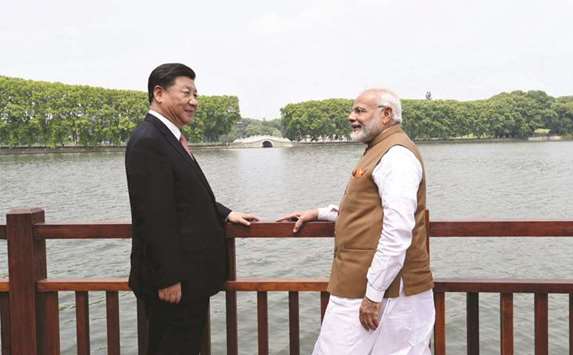When Chinese Premier Li Keqiang smiled with Japanese Prime Minister Shinzo Abe at a reception in Tokyo recently, it served as a reminder of just how rare these types of warm gestures have been between the Asian neighbours.
The first visit by a Chinese premier to Japan in seven years was the latest step in Beijing’s attempt to shore up fraught ties with other powers to counter escalating tensions with the US. It came after an equally congenial visit to Indonesia, and Chinese President Xi Jinping’s unexpected rapprochements with Indian Prime Minister Narendra Modi and North Korea’s Kim Jong-un.
“It’s inevitable there will be differences of opinion and friction,” Li told executives at a reception marking the 40th anniversary of a friendship treaty with Japan. “But I want to maintain the overall direction of friendship, keep to the spirit of the treaty and build a bright future together,” NHK reported him as saying.
Threatened by looming trade sanctions from Washington, China is seeking support from other nations to counter US pressure. A Chinese official told Bloomberg News last month that the government was considering offering major concessions on trade and investment to the European Union and countries such as Japan and Mexico.
“China is trying to make an opportunity out of a bad situation. The Trump administration’s moves on trade could negatively affect the Chinese economy at a time when it faces many internal challenges,” said Mary Gallagher, director of the Center for Chinese Studies at the University of Michigan. “But the US has also antagonised many of its important trading partners and allies, so China is smart to try to counter the US.”
The shift has required China to lay aside some of its most intense foreign disputes. Chinese and Indian soldiers faced off in the Doklam region along their border last year and Beijing and Tokyo still haven’t resolved their 2012 confrontation over control of East China Sea islands that plunged relations to their lowest point in decades.
In Xi’s meeting with Modi in April, the two emphasised that they would avoid border clashes. Meanwhile, Japan and China signed a memorandum on a maritime communication mechanism aimed at avoiding unintended clashes at sea.
“By changing the Japan-China relationship from one of competition to one of harmony, we can contribute greatly to the peace and stability of the Asian region, as well as to its prosperity,” Abe told parliament on May 14.
How far China can take the strategy remains to be seen. Many of China’s neighbours, including Japan and India, are concerned about Beijing’s rising might, especially its willingness to use coercive economic policies to punish countries that run afoul of its goals. South Korea experienced that last year after deploying a US missile shield.
Even as Xi and Li mend fences with Japan and India, they’ve seen tensions rise with Australia over its efforts to limit perceived Chinese political meddling. And revelations that missiles and other military equipment have been deployed on China’s South China Sea outposts have rekindled concerns about its efforts to establish control over that disputed water body. In a demonstration of its growing military prowess, China’s first domestically built aircraft carrier began sea trials on May 13, Xinhua news agency said.
“The smile diplomacy can be successful, but only within certain limits,” said June Teufel Dreyer, a University of Miami political science professor and author of Middle Kingdom and Empire of the Rising Sun – a 2016 book on China-Japan ties. “There are restraints on how much Beijing’s willing to make concessions, as well as on other sides’ willingness to make reciprocal gestures.”
Officials from Beijing are trying to cast themselves as defenders of the multilateral trade system, countering US-led criticism of restricted access to Beijing’s markets.
“Both China and Indonesia believe in globalisation and free trade,” Li told more than 600 business people at a recent China-Indonesia business summit, according to the official Xinhua News Agency. “We both support the rules-based multilateral trading regime and stand for equal consultation in settling trade disputes.”
Li and Abe oversaw the signing of a raft of agreements, including one allowing the transfer of two crested ibises from China as a symbol of a friendship recovering from its worst crisis in decades. China also granted Japanese financial institutions the status of renminbi-qualified foreign institutional investor, enabling them to directly invest in Chinese securities and finally placing Japan on the same footing as Western economies.
Abe accompanied the Chinese premier on a trip to the northern island of Hokkaido, where they emphasised business ties by touring a Toyota Motor Corp plant together. The visit underscored the shared interest in free trade between the world’s second-and third-largest economies.
“The current tension between China and the US has required China to have a greater degree of interdependence with its neighbours,” said Yang Bojiang, deputy director of the Institute of Japanese Studies at the Chinese Academy of Social Sciences, a state research institution. “The strengthening of China’s international co-operation is a response to US trade protectionism, unilateralism, and other trends that do not conform to the times.”

Chinese President Xi Jinping and India’s Prime Minister Narendra Modi speak as they walk along the East Lake in Wuhan, China on April 28. Threatened by looming trade sanctions from Washington, China is seeking support from other nations to counter US pressure.


